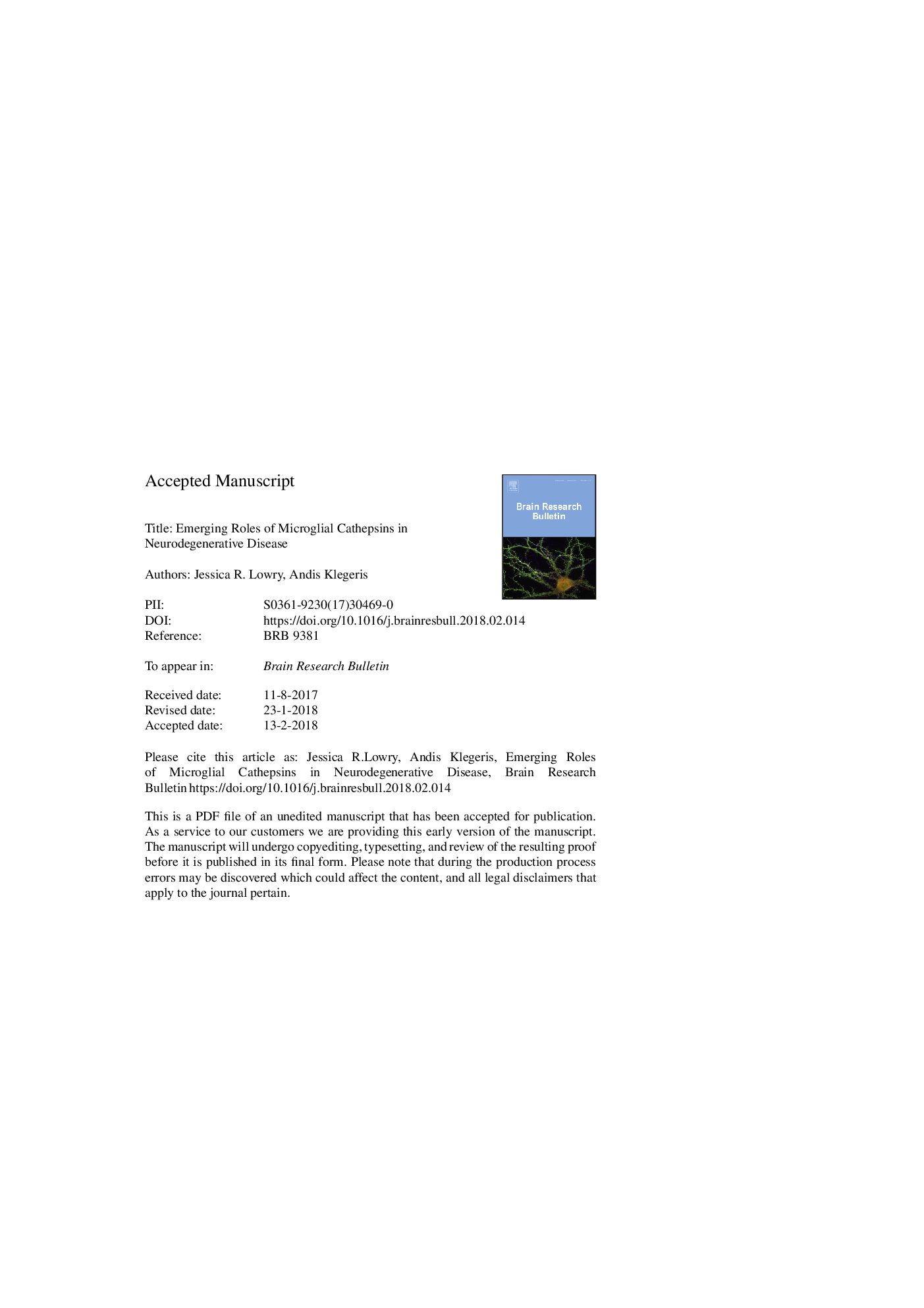| کد مقاله | کد نشریه | سال انتشار | مقاله انگلیسی | نسخه تمام متن |
|---|---|---|---|---|
| 8838897 | 1613218 | 2018 | 58 صفحه PDF | دانلود رایگان |
عنوان انگلیسی مقاله ISI
Emerging roles of microglial cathepsins in neurodegenerative disease
ترجمه فارسی عنوان
نقش های در حال رشد از کاتهپسین های میکروگلیال در بیماری های نوروژنیک
دانلود مقاله + سفارش ترجمه
دانلود مقاله ISI انگلیسی
رایگان برای ایرانیان
کلمات کلیدی
ECMPS1IκBAPPHspiNOSNCLAβNADPHNLRP3LPSNF-κBMMPTNFTBIneuronal ceroid lipofuscinosis - lipophuscinosis ceroid neuronalMAPK - MAPKpresenilin 1 - Presenilin 1ROS - ROSAdenosine Triphosphate - آدنوزین تری فسفاتATP - آدنوزین تری فسفات یا ATPTraumatic brain injury - آسیب تروماتیک مغزNeuroinflammation - التهاب عصبیinterferon - اینترفرونIFN - اینترفرون هاinterleukin - اینترلوکینAlzheimer’s disease - بیماری آلزایمرParkinson’s disease - بیماری پارکینسونCNS - دستگاه عصبی مرکزیBBB - سد خونی مغزیglial cells - سلول های گلیالinducible nitric oxide synthase - سنتاز اکسید نیتریک القاییcentral nervous system - سیستم عصبی مرکزیtumor necrosis factor - فاکتور نکروز تومورnuclear factor kappa-light-chain-enhancer of activated B cells - فاکتور هسته ای kappa-light-chain-enhancer از سلول های B فعال شده استlipopolysaccharide - لیپوپلی ساکاریدExtracellular matrix - ماتریکس خارج سلولیmatrix metalloproteinase - ماتریکس متالوپروتئینازBlood-brain barrier - مانع خون مغزیNeuroprotection - محافظت نورونی یا محافظت از عصبNF-κB inhibitor - مهارکننده NF-κBNitric oxide - نیتریک اکسیدnicotinamide adenine dinucleotide phosphate - نیکوتین آمید adenine dinucleotide phosphateHeat shock protein - پروتئین شوک حرارتamyloid precursor protein - پروتئین پیش ماده آمیلوئیmitogen-activated protein kinase - پروتئین کیناز فعال با mitogennod-like receptor protein 3 - پروتئین گیرنده مانند گربه 3amyloid-β peptide - پپتید آمیلیید بReactive oxygen species - گونههای فعال اکسیژن
موضوعات مرتبط
علوم زیستی و بیوفناوری
علم عصب شناسی
علوم اعصاب سلولی و مولکولی
چکیده انگلیسی
Alzheimer's disease (AD) is one of the leading causes of dementia, and its prevalence is expected to increase dramatically due to the aging global population. Microglia-driven neuroinflammation may contribute to the progression of AD. Microglia, the immune cells of the central nervous system (CNS), become chronically activated by the pathological proteins of AD including amyloid-β peptides (Aβ). Such adversely activated microglia secrete mediators that promote inflammation and damage neurons. Cathepsins are proteases that are expressed by all brain cell types, and most of them are found both intra- and extra-cellularly. Microglia express and secrete several different cathepsins, which support various immune functions of microglia, in addition to their involvement in key neuroinflammatory pathways. This review focuses specifically on microglial cathepsins B, D and S, which have been implicated in AD pathogenesis; we identify their roles relevant to microglial involvement in AD pathogenesis. As dysregulated microglial function and neuroinflammation can contribute to AD progression, cathepsins should be considered as potential therapeutic targets for the development of effective AD treatment options. We conclude that the specific inhibition of microglial cathepsin B may lead to neuroprotective outcomes in AD, while the functions of this cysteine protease in neurons appears to be very complex and further studies are required to fully elucidate the pathophysiological role of neuronal cathepsin B. Examination of the CNS roles of cathepsins is limited by the shortage of highly selective inhibitors, with CA-074 being the only available specific cathepsin B inhibitor. We also conclude that non-specific inhibition of aspartic proteases, including cathepsin D, may promote adverse CNS effects, and may not be safe as AD therapeutics. Finally, cathepsin S inhibition has shown promise in preclinical studies due to its neuroprotective and anti-inflammatory effects; however, the many homeostatic roles of cathepsin S must be considered during the subsequent stages of development of cathepsin S inhibitors as AD therapeutics. Discovery of novel, highly selective inhibitors of various cathepsins and their clinical testing are required for the development of effective future AD therapies.
ناشر
Database: Elsevier - ScienceDirect (ساینس دایرکت)
Journal: Brain Research Bulletin - Volume 139, May 2018, Pages 144-156
Journal: Brain Research Bulletin - Volume 139, May 2018, Pages 144-156
نویسندگان
Jessica R. Lowry, Andis Klegeris,
